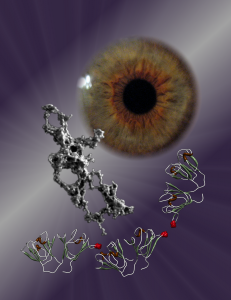 The eye lens consists of cells that lose their organelles during embryonic development, leaving elongated structures that have no means of protein synthesis. Therefore, protein molecules formed before birth must remain stable and soluble throughout the life of the organism. The eye lens contains a very high concentration of proteins, most of which are crystallins. There are two major types of crystallins: alpha-crystallins, which bind damaged proteins in the lens to keep them in solution, and beta/gamma-crystallins, which are mostly composed of antiparallel beta-sheets and function as structural proteins. In the healthy eye lens, local order between the crystallin molecules maintains transparency despite the high protein concentration.
The eye lens consists of cells that lose their organelles during embryonic development, leaving elongated structures that have no means of protein synthesis. Therefore, protein molecules formed before birth must remain stable and soluble throughout the life of the organism. The eye lens contains a very high concentration of proteins, most of which are crystallins. There are two major types of crystallins: alpha-crystallins, which bind damaged proteins in the lens to keep them in solution, and beta/gamma-crystallins, which are mostly composed of antiparallel beta-sheets and function as structural proteins. In the healthy eye lens, local order between the crystallin molecules maintains transparency despite the high protein concentration.
Cataract, which is a major cause of blindness, results when one or more of the structural crystallins aggregate, causing opacity of the lens. This appears to occur after alpha-crystallins have been titrated out. We are using optical spectroscopy as well as solution and solid-state NMR to investigate both the native and aggregated states of gammaS-crystallin. Solid-state NMR methods that have been previously applied to other locally-ordered systems, such as amyloid fibrils and silk, will allow comparisons between the structures of the cataract aggregate and the native protein. Discovering the differences between these two states of gammaS-crystallin will elucidate the process of cataract formation and may lead to the design of new therapeutics or artificial eye lens materials.
